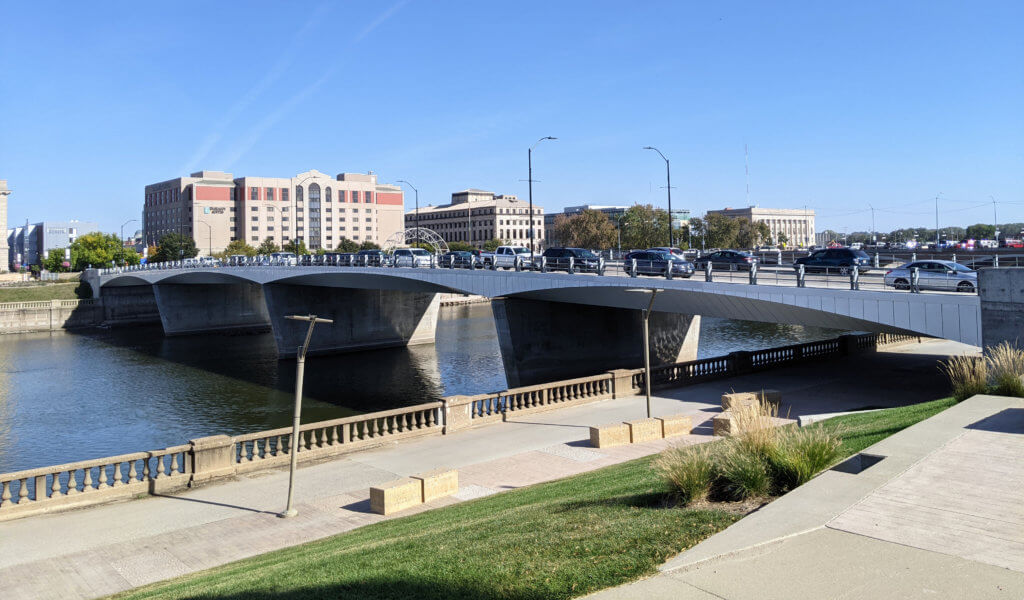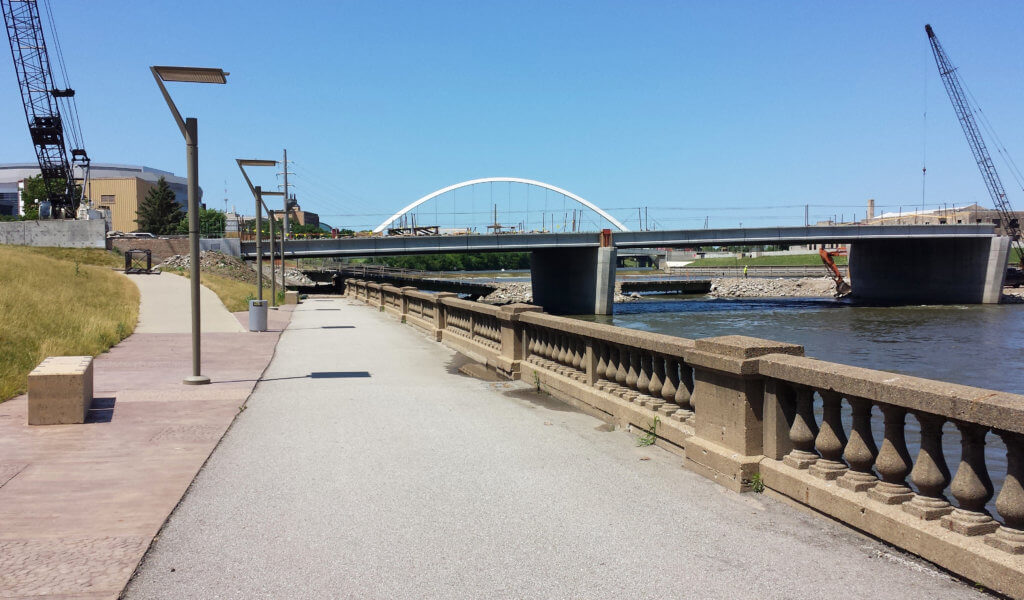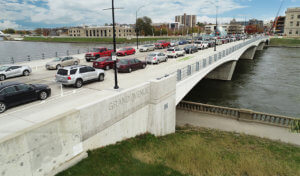
Historic Bridge Replacement Mimics Changes to Nearby Grand Avenue Bridge in Des Moines
Opened in 1909, the Locust Street Bridge was one of a series of four bridges (Locust Street, Walnut Street, Grand Avenue, Court Avenue) built between 1907 and 1918 spanning the Des Moines River in the heart of Iowa’s capital city. Over the years, these ornately decorated, reinforced-concrete arch structures became symbols of the city’s rich history. They also provide a critical link connecting the East Village with the downtown Des Moines business district.
In the late 1960s, the Locust Street, Walnut Street, and Grand Avenue bridge decks were reconstructed along with other improvements. As a cost-saving measure, most of the original ornamentation was removed, leaving only the arched spans and piers. After another half-decade of use, the time came again in the 2010s to either renovate the existing structures or build entirely new bridges. Focusing on the Grand Avenue Bridge, the professionals with Shuck-Britson were brought on board to help develop the designs for completely replacing this iconic structure.
Deteriorated Structure Requires Complete Replacement
Fast forward several years, with the reconstructed Grand Avenue Bridge open and operating as intended, the team from Shuck-Britson was once again tasked with performing the same duties for the replacement of the Locust Street Bridge. Much like the bridge on Grand Avenue, the engineering team found the Locust Street Bridge to be structurally deficient with scour-critical concrete piers and poor hydraulic performance.
The Shuck-Britson team developed plans for a pretensioned, prestressed concrete (PPC) beam bridge that would maximize the use of standard construction details and could be constructed for under $10 million. The design copied many of the same aesthetic details as the newly reconstructed Grand Avenue Bridge, including the use of scalloped metal panels along the sides of the bridge. As already established, this design satisfies the requirements of efficiency and economy.
Unique Features, Bridge Details, & Design Challenges
While the four-span, 446-foot long, 42-foot wide, concrete-beam bridge is 12-feet narrower than the Grand Avenue Bridge, it was designed to support two lanes of traffic, on-street parking, and 12-foot-wide sidewalks on both sides. A non-standard deck cross-section was incorporated to raise the pedestrian sidewalk above the roadway. A modified crash rail protects pedestrians, while the raised sidewalks with extended overhangs enhance the dramatic effect of the scalloped fascia panels.
The engineering team also added beamlines under the raised pedestrian sidewalk to support a snooper truck for future under-bridge inspections and maintenance. The additional sidewalk load resulted in nonuniform beam reactions requiring careful analysis to determine the proper reinforcing strand and shear stirrup patterns, as well as bearing pad sizes. Further, more than 18 separate utility conduits were incorporated into or below the new bridge deck along with a new, 20-inch water main.
Also like the Grand Avenue Bridge location, the bridge abutments at Locust Street were designed to penetrate the levee on both riverbanks while still maintaining flood protection for the city, with the new bridge abutments sized to match the locations of the floodwalls. To minimize excavation and disturbance to the existing floodwalls, large portions of the original massive abutments were left in place. The new prototypical, semi-integral abutments were developed to account for the pile fixity caused by the rigid connection/incorporation into the existing abutments.
With the pier footings for the new bridge supported on steel piles extending to bedrock, one less pier was required, increasing the flow area of the river by nearly twenty percent. Additionally, the bridge is designed to withstand the hydraulic effects of a 100-year frequency flood event and the intense water pressure acting against the bridge fascia.
Expert Coordination & Collaboration Lead to Aggressive Build Schedule
Following the demolition of the previous structure, construction began on the new bridge. The shallow river depth allowed for the use of temporary causeways during construction with a minimal impact on the environment. Even though work was temporarily delayed in 2019 due to high river levels, work wrapped up in September of 2020.
The Shuck-Britson team, along with parent company Snyder & Associates, made the project possible by collaborating to provide the development of project concept statement, preliminary bridge and roadway plans, hydraulic analysis and documentation, final bridge and roadway design plans, as well as the extensive coordination and development of aesthetic details. Also, the design team provided rapid response service for issues that arose during construction. These included addressing unanticipated site conditions, pile driving inquiries, and general construction observation.
With the Grand Avenue and Locust Street Bridges complete, plans are underway to let the Walnut Street Bridge in 2022. The innovative aesthetics on the new bridges is viewed as a visual complement to the Iowa Women of Achievement Bridge located just upstream from Grand Avenue and helped to transform the downtown river area for a new generation.







